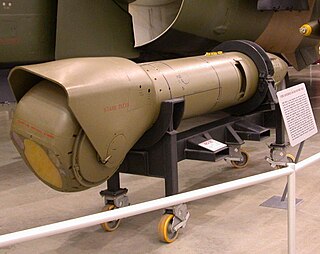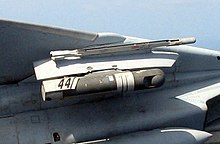
The Lockheed AC-130 gunship is a heavily armed, long-endurance, ground-attack variant of the C-130 Hercules transport, fixed-wing aircraft. It carries a wide array of ground-attack weapons that are integrated with sensors, navigation, and fire-control systems. Unlike other modern military fixed-wing aircraft, the AC-130 relies on visual targeting. Since its large profile and low operating altitudes around 7,000 feet make it an easy target, its close air support missions are usually flown at night.

The Grumman F-14 Tomcat is an American carrier-capable supersonic, twin-engine, two-seat, twin-tail, all-weather-capable variable-sweep wing fighter aircraft. The Tomcat was developed for the United States Navy's Naval Fighter Experimental (VFX) program after the collapse of the General Dynamics-Grumman F-111B project. A large and well-equipped fighter, the F-14 was the first of the American Teen Series fighters, which were designed incorporating air combat experience against MiG fighters during the Vietnam War.

The Lockheed S-3 Viking is a four-crew, twin-engine turbofan-powered jet aircraft designed and produced by the American aerospace manufacturer Lockheed Corporation. Because of its characteristic sound, it was nicknamed the "War Hoover" after the vacuum cleaner brand.

PAVE is a United States Air Force program identifier relating to electronic systems. Prior to 1979, Pave was said to be a code word for the Air Force unit responsible for the project. Pave was used as an inconsequential prefix identifier for a wide range of different programs, though backronyms and alternative meanings have been used. For example, in the helicopters Pave Low and Pave Hawk it was said to mean Precision Avionics Vectoring Equipment, but in PAVE PAWS it was said to mean Precision Acquisition Vehicle Entry.

Paveway is a series of laser-guided bombs (LGBs).

A laser-guided bomb (LGB) is a guided bomb that uses semi-active laser guidance to strike a designated target with greater accuracy than an unguided bomb. First developed by the United States during the Vietnam War, laser-guided bombs quickly proved their value in precision strikes of difficult point targets. These weapons use on-board electronics to track targets that are designated by laser, typically in the infrared spectrum, and adjust their glide path to accurately strike the target. Since the weapon is tracking a light signature, not the object itself, the target must be illuminated from a separate source, either by ground forces, by a pod on the attacking aircraft, or by a separate support aircraft.

The McDonnell DouglasF-15E Strike Eagle is an American all-weather multirole strike fighter derived from the McDonnell Douglas F-15 Eagle. The F-15E was designed in the 1980s for long-range, high-speed interdiction without relying on escort or electronic-warfare aircraft. United States Air Force (USAF) F-15E Strike Eagles can be generally distinguished from other US Eagle variants by darker aircraft camouflage, conformal fuel tanks (CFTs) mounted along the engine intake ramps and a tandem-seat cockpit.

The Lockheed Martin AN/AAS-35(V) Pave Penny is a laser spot tracker carried by US Air Force attack aircraft and fighter-bombers to enable them to track a laser spot on the ground. It is a receiver only, allowing the pilot to see which targets may be attacked by any laser-guided bombs they carry.

The Ford Aerospace AN/AVQ-26 Pave Tack is an electro-optical targeting pod for military attack aircraft. It uses a laser and a forward looking infrared to find and designate targets for laser-guided bombs and other precision-guided munitions. Pave Tack's images are routed to a cockpit display, usually for the weapon systems officer.

The Lockheed Martin Sniper is a targeting pod for military aircraft that provides positive target identification, autonomous tracking, GPS coordinate generation, and precise weapons guidance from extended standoff ranges.

Targeting pods (TGP) are target designation tools used by attack aircraft for identifying targets and guiding precision-guided munition (PGM) such as laser-guided bombs to those targets. The first targeting pods were developed in conjunction with the earliest generation of PGMs in the mid-1960s.

The AN/AAQ-28 Litening targeting pod is an advanced precision targeting pod system currently operational with a wide variety of aircraft worldwide. The research and development of the Litening was first undertaken by Rafael Advanced Defense Systems' Missiles Division in Israel, with subsequent completion of Litening I for use in the Israeli Air Force.

An Infrared Search and Track (IRST) system is a method for detecting and tracking objects which give off infrared radiation, such as the infrared signatures of jet aircraft and helicopters.

An air superiority fighter is a fighter aircraft designed to seize control of enemy airspace by establishing tactical dominance over the opposing air force. Air-superiority fighters are primarily tasked to perform aerial combat against agile, lightly armed aircraft and eliminate any challenge over control of the airspace, although some may have a secondary role for air-to-surface attacks.

A guided bomb is a precision-guided munition designed to achieve a smaller circular error probable (CEP).
Lockheed Martin Missiles and Fire Control (MFC) is one of the four core business areas for American company Lockheed Martin.
Blue Sky is a combined airborne navigation and targeting pod system for Chinese military aircraft. It is designed to provide aircraft with all-weather/night-attack capabilities. It is the Chinese equivalent of the United States Air Force LANTIRN system. Several derivatives have already been developed since its public debut.
The FILAT pod is an airborne targeting pod designed to provide aircraft with all weather/night attack capabilities. It was first revealed to the public at 1998 Zhuhai Air Show, and it is designed by the 613 Institute of AVIC.

A large number of variants of the General Dynamics F-16 Fighting Falcon have been produced by General Dynamics, Lockheed Martin, and various licensed manufacturers. The details of the F-16 variants, along with major modification programs and derivative designs significantly influenced by the F-16, are described below.

A precision-guided munition (PGM), also called a smart weapon, smart munition, or smart bomb, is a type of weapon system that integrates advanced guidance and control systems, such as GPS, laser guidance, or infrared sensors, with various types of munitions, typically missiles or artillery shells, to allow for high-accuracy strikes against designated targets. PGMs are designed to precisely hit a predetermined target, typically with a margin of error that is far smaller than conventional unguided munitions. Unlike unguided munitions, PGMs use active or passive control mechanisms capable of steering the weapon towards its intended target. PGMs are capable of mid-flight course corrections, allowing them to adjust and hit the intended target even if conditions change. PGMs can be deployed from various platforms, including aircraft, naval ships, ground vehicles, ground-based launchers, and UAVs. PGMs are primarily used in military operations to achieve greater accuracy, particularly in complex or sensitive environments, to reduce the risk to operators, lessen civilian harm, and minimize collateral damage. PGMs are considered an element of modern warfare to reduce unintended damage and civilian casualties. It is widely accepted that PGMs significantly outperform unguided weapons, particularly against fortified or mobile targets.





















